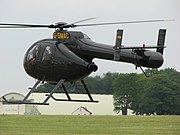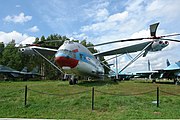Rotor configurations
Most helicopters have a single, main rotor but require a separate rotor to overcome torque. This is accomplished through a variable pitch, antitorque rotor or tail rotor. This is the design that Igor Sikorsky settled on for his VS-300 helicopter and it has become the recognized convention for helicopter design, although designs do vary. When viewed from above, designs from Germany, United Kingdom and the United States are said to rotate counter-clockwise, all others are said to rotate clockwise. This can make it difficult when discussing aerodynamic effects on the main rotor between different designs, since the effects may manifest on opposite sides of each aircraft.
Single main rotor
| Antitorque | |
|---|---|
| Torque effect on a helicopter |
With a single main rotor helicopter, the creation of torque as the engine turns the rotor creates a torque effect which causes the body of the helicopter to turn in the opposite direction of the rotor. To eliminate this effect, some sort of antitorque control must be used, with a sufficient margin of power available to allow the helicopter to maintain its heading and provide yaw control. The three most common controls used today are the traditional tail rotor, Eurocopter's Fenestron (also called a fantail), and MD Helicopters' NOTAR.
Tail rotor
The tail rotor is a smaller rotor mounted vertically or near-vertical on the tail of a traditional single-rotor helicopter. The tail rotor either pushes or pulls against the tail to counter the torque. The tail rotor drive system consists of a drive shaft powered from the main transmission and a gearbox mounted at the end of the tail boom. The drive shaft may consist of one long shaft or a series of shorter shafts connected at both ends with flexible couplings. The flexible couplings allow the drive shaft to flex with the tail boom. The gearbox at the end of the tailboom provides an angled drive for the tail rotor and may also include gearing to adjust the output to the optimum RPM for the tail rotor. On some larger helicopters, intermediate gearboxes are used to transition the tail rotor drive shaft from along the tailboom or tailcone to the top of the tail rotor pylon which also serves as a vertical stabilizing airfoil to alleviate the power requirement for the tail rotor in forward flight. It may also serve to provide limited antitorque within certain airspeed ranges in the event that the tail rotor or the tail rotor flight controls fail.
Ducted fan
-
Main article: Fenestron
Fenestron and FANTAIL[17] are trademarks for a ducted fan mounted at the end of the tail boom of the helicopter and used in place of a tail rotor. Ducted fans have between eight and 18 blades arranged with irregular spacing, so that the noise is distributed over different frequencies. The housing is integral with the aircraft skin and allows a high rotational speed, therefore a ducted fan can have a smaller size than a conventional tail rotor.
The Fenestron was used for the first time at the end of the 1960s on the second experimental model of Sud Aviation's SA 340, and produced on the later model Aérospatiale SA 341 Gazelle. Besides Eurocopter and its predecessors, a ducted fan tail rotor was also used on the canceled military helicopter project, the United States Army's RAH-66 Comanche, as the FANTAIL.
NOTAR
-
Main article: NOTAR
NOTAR, an acronym for NO TAil Rotor, is a relatively new helicopter anti-torque system which eliminates the use of the tail rotor on a helicopter. Although the concept took some time to refine, the NOTAR system is simple in theory and works to provide antitorque the same way a wing develops lift using the Coandă effect.[18] A variable pitch fan is enclosed in the aft fuselage section immediately forward of the tail boom and driven by the main rotor transmission. This fan forces low pressure air through two slots on the right side of the tailboom, causing the downwash from the main rotor to hug the tailboom, producing lift, and thus a measure of antitorque proportional to the amount of airflow from the rotorwash. This is augmented by a direct jet thruster (which also provides directional yaw control) and vertical stabilizers.
Development of the NOTAR system dates back to 1975 when engineers at Hughes Helicopters began concept development work.[18] In December 1981 Hughes flew a OH-6A fitted with NOTAR for the first time.[19] A more heavily modified prototype demonstrator first flew in March 1986 and successfully completed an advanced flight-test program, validating the system for future application in helicopter design.[20] There are currently three production helicopters that utilize the NOTAR system, all produced by MD Helicopters. This antitorque design also improves safety by eliminating the opportunity for personnel to walk into the tail rotor.[verification needed]
Tip jets
-
Main article: Tip jet
Another single main rotor configuration without a tail rotor is the tip jet rotor, where the main rotor is not driven by the mast, but from nozzles on the tip of the rotor blade; which are either pressurized from a fuselage-mounted gas turbine or have their own turbojet, ramjet or rocket thrusters. Although this method is simple and eliminates torque, the prototypes that have been built are less fuel efficient than conventional helicopters and produce more noise. One example, the Percival P.74, was not even able to leave the ground, and the Hiller YH-32 Hornet had good lifting capability but was otherwise poor. The Fairey Jet Gyrodyne and 40-seat Fairey Rotodyne flew very well indeed. Possibly the most unusual was the rocket tipped Rotary Rocket Roton ATV. None have made it into production.
[edit] Dual rotors (contra-rotating)
Contra-rotating rotors, are rotorcraft configurations with a pair or more of large horizontal rotors turning in opposite directions to counteract the effects of torque on the aircraft without relying on an antitorque tail rotor. Primarily, there are three common configurations that utilize the contra-rotating effect to benefit the rotorcraft; tandem rotors are two rotors with one mounted behind the other, coaxial rotors are two rotors that are mounted one above the other with the same axis, and intermeshing rotors are two rotors that are mounted close to each other at enough angle to allow the rotors to intermesh over the top of the aircraft. Another configuration found on tiltrotors and some earlier helicopters is called transverse rotors where the pair of rotors is mounted at each end of a wing-type structure or outriggers.
Tandem
-
Main article: Tandem rotors
Tandem rotors are two horizontal main rotor assemblies mounted one behind the other. Tandem rotors achieve pitch attitude changes to accelerate and decelerate the helicopter through a process called differential collective pitch. To pitch forward and accelerate, the rear rotor increases collective pitch, raising the tail and the front rotor decreases collective pitch, simultaneously dipping the nose. To pitch upward while decelerating (or moving rearward), the front rotor increases collective pitch to raise the nose and the rear rotor decreases collective pitch to lower the tail. Yaw control is developed through opposing cyclic pitch in each rotor; to pivot right, the front rotor tilts right and the rear rotor tilts left, and to pivot left, the front rotor tilts left and the rear rotor tilts right.
Coaxial
-
Main article: Coaxial rotors
Coaxial rotors are a pair of rotors turning in opposite directions, but mounted on a mast, with the same axis of rotation, one above the other. The advantage of the coaxial rotor is that, in forward flight, the lift provided by the advancing halves of each rotor compensates for the retreating half of the other, eliminating one of the key effects of dissymmetry of lift; retreating blade stall. However, other design considerations plague coaxial rotors. There is an increased mechanical complexity of the rotor system because it requires linkages and swashplates for two rotor systems. Add that each rotor system needs to be turned in opposite directions means that the mast itself is more complex, and provisions for making pitch changes to the upper rotor system must pass through the lower rotor system.
Intermeshing
-
Main article: Intermeshing rotors
Intermeshing rotors on a helicopter are a set of two rotors turning in opposite directions, with each rotor mast mounted on the helicopter with a slight angle to the other so that the blades intermesh without colliding. This configuration is sometimes referred to as a synchropter. Intermeshing rotors have high stability and powerful lifting capability. The arrangement was successfully used in Nazi Germany for a small anti-submarine warfare helicopter, the Flettner Fl 282 Kolibri. During the Cold War, the American company, Kaman Aircraft produced the HH-43 Huskie for the USAF firefighting and rescue missions. The latest Kaman model, the Kaman K-MAX, is a dedicated sky crane design.
Transverse
Transverse rotors are mounted on the end of wings or outriggers, perpendicular to the body of the aircraft. Similar to tandem rotors and intermeshing rotors, the transverse rotor also utilizes differential collective pitch. But like the intermeshing rotors, the transverse rotors use the concept for changes in the roll attitude of the rotorcraft. This configuration is found on two of the first viable helicopters, the Focke-Wulf Fw 61 and the Focke-Achgelis Fa 223, as well as the world's largest helicopter ever built, the Mil Mi-12. It is also the configuration found on tiltrotors, such as Bell's XV-15 and the newer V-22 Osprey.








